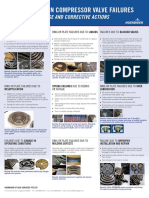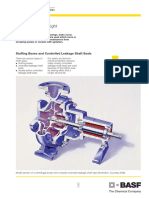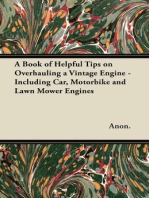Valve Failure Poster
Valve Failure Poster
Uploaded by
yohan pramonoCopyright:
Available Formats
Valve Failure Poster
Valve Failure Poster
Uploaded by
yohan pramonoOriginal Description:
Copyright
Available Formats
Share this document
Did you find this document useful?
Is this content inappropriate?
Copyright:
Available Formats
Valve Failure Poster
Valve Failure Poster
Uploaded by
yohan pramonoCopyright:
Available Formats
MOST COMMON COMPRESSOR VALVE FAILURES
CAUSE AND CORRECTIVE ACTIONS
RING OR PLATE FAILURES DUE TO DEBRIS RING OR PLATE FAILURES DUE TO LIQUIDS FAILURES DUE TO BLOCKED VALVES
n Source of debris are from the gas stream or broken valve n Valve plate failure due to liquid or condensate is a typical n Blocked valves are mostly a result of the process and
components process related issue are commonly seen in polyethylene plants or HDS or
CCR applications in refineries.
n Scarring can often be seen on the seat and guard as well n Metallic sealing element will become rusty whenever
n It is common to see debris scars alongside other failure there is condensation, lifespan is then shortened. n Blocked valves will lead to high differential pressure
modes so it is not necessarily the root cause of a failure n Liquids are generally driven to the center of the valve across the valve seat and could lead to cracks in the
by the gas flow seat. Blocked valves could result in safety issues as
they impact on rod load reversals if the gas cannot be
n Water hammer effect inflicted damage to the center of the released to the discharge line.
plate, innermost rings may be broken and do
seldom occur on the outside of the plate n Sticky material can initially also lead to plate stiction
and high opening impact of valve plate.
n Springs may be collapsed
Remedy: Upgrade to Non metallic plates if possible.
Reevaluate valve design. Non metallic plates can Remedy: Prevent condensation e.g. by insulating of suction Remedy: Besides improving process related equipment
usually survive longer than metallic in the presence line, prevent liquid carry-over, suitable cooling rate for the upstream the compressor, a valve upgrade to ring type.
of moderate debris. cylinder. Consider ring or profiled plate type valve. Profiled ring/plate type valves with anti-stiction designed
guard will make an improvement.
RING OR PLATE FAILURES DUE TO SPRING FAILURES DUE TO DEBRIS RING OR PLATE FAILURES DUE TO OVER
MISAPPLICATION OR FATIGUE LUBRICATION
n Oil stiction effects leads to high impact of the
n Melted non-metallic sealing elements are normally n Sand or welding slag enters the spring pockets (Usually conventional valve plate, ring.
a sign that the compressor ran for an extended a transient event and common after startups)
period with leaking valves, was exposed to very high n Outer section of valve plate starts failing because of
temperature, or when a material selection for a specific n Debris may scar the coils and provide a failure initiation imbalanced movement of sealing element
operating condition was incorrect point
n Plate valves are vulnerable to excessive lube
n Spring fatigue failure leads to high impact of the metallic
n Springs are often stuck in sealing element If lube rates can’t be reduced, conversion to a profiled
valve plate n
n Air compressors tend to have surging in temperature. geometry valve may minimise the issue
n Outer section of valve plate starts failing
n One or multiple springs collapsed
Remedy: Reduce cylinder lubrication rate (if possible),
increase spring force or change valve type or profiled ring/plate
in combination with profiled guard can improve reliability
Remedy: Re-engineering of spring load required. Reduction
of dynamic spring loading by using different spring type,
different spring pocket depths and / or lower valve lift.
Remedy: Upgrade to metallic sealing element. Reengineer
valves when process change occurred or a new duty has
been applied.
FAILURES DUE TO CHANGE IN RING OR PLATE FAILURES DUE TO FAILURE DUE TO IMPROPER
OPERATING CONDITIONS MOLDING DEFECTS INSTALLATION AND REPAIR
Any changes in operating condition such as compressor Generally, poor material quality could lead to longitudinal n Broken guard: suction valve was loose in valve pocket
speed, operating pressure and gas composition will cracks and jagged, crumbled, break surface indicate a due to improper torque of valve covers which caused
affect valve performance. Valve inner components might molding defects in the material. damage to multiple elements
be damaged and consequently pre-mature valve failure
occurred. n Seat lands too wide outside of specs or plate was flipped
then reused
n Top locking nut not used or reused
Remedy: Re-evaluate valve performance before any changes
applied to the process.
Remedy: Selecting experienced supplied and improve
material selection.
HOERBIGER KT ASIA SERVICES PTE LTD Remedy: Follow HOERBIGER repair procedures and change
all required consumables during servicing!
77 Joo Koon Circle, Singapore 629097 Tel: +65 6890 0770 Fax: +65 6890 8037 Email: info-asia@hoerbiger.com
You might also like
- HLX5 Drifter Failure Guide (Rev3)Document57 pagesHLX5 Drifter Failure Guide (Rev3)Leo75% (4)
- 4G15B 4G15T Service Manual20160106 EDocument196 pages4G15B 4G15T Service Manual20160106 ESantiago CosNo ratings yet
- c2165 Mouse SocDocument12 pagesc2165 Mouse SocEinar César Santos50% (4)
- How To Solve Blow Molding ProblemsDocument12 pagesHow To Solve Blow Molding ProblemsOmar EstradaNo ratings yet
- Valve Failure Poster PDFDocument1 pageValve Failure Poster PDFyohan pramonoNo ratings yet
- Most Common Compressor Valve Failures 1699725592Document1 pageMost Common Compressor Valve Failures 1699725592tmbadr2015No ratings yet
- Driskell - Select The Right Control ValveDocument5 pagesDriskell - Select The Right Control ValveDefenceDogNo ratings yet
- Importance of Maintaining Valve RecordsDocument5 pagesImportance of Maintaining Valve Recordsmuthu kujmarNo ratings yet
- EN75558 FP TroubleshootingGuideDocument8 pagesEN75558 FP TroubleshootingGuideALEXSANDRONo ratings yet
- G - Analysis of Chain DamageDocument17 pagesG - Analysis of Chain DamageTegoarNo ratings yet
- Stuck Pipe PDFDocument27 pagesStuck Pipe PDFduncmcleod100% (1)
- Pneumatic Troubleshooting ChartsDocument6 pagesPneumatic Troubleshooting ChartsSHRAVAN KUMARNo ratings yet
- Installation, Maintenance and Operating Instructions Cast Iron, Malleable Iron and Bronze Globe ValvesDocument4 pagesInstallation, Maintenance and Operating Instructions Cast Iron, Malleable Iron and Bronze Globe ValvesmahmadwasiNo ratings yet
- Dangerous Effect of Moisture On Paper and AgeingDocument10 pagesDangerous Effect of Moisture On Paper and Ageingraza239No ratings yet
- Compresores SandenDocument81 pagesCompresores SandenMiguel Carlin JimenezNo ratings yet
- BMV Brochure 4 Page Web - 2019Document4 pagesBMV Brochure 4 Page Web - 2019Velibor StokicNo ratings yet
- Transformer Failure AnalysisDocument12 pagesTransformer Failure AnalysisABHINAV SAURAV100% (1)
- Advantages and DisadvantagesDocument1 pageAdvantages and DisadvantagesThomas JoseNo ratings yet
- Poppet Exhaust-Valve Design: Illustratedwith DRAWINGSDocument6 pagesPoppet Exhaust-Valve Design: Illustratedwith DRAWINGSGhanvir SinghNo ratings yet
- 012 Water Control-Abbas RadhiDocument16 pages012 Water Control-Abbas RadhiNasih Noori100% (1)
- Inspection of Steel Penstocks and Pressure ConduitsDocument111 pagesInspection of Steel Penstocks and Pressure ConduitsNgoc Thach PhamNo ratings yet
- Class IV Dec21Document15 pagesClass IV Dec21Qaiser khanNo ratings yet
- Failure Mechanisms For Hoses PDFDocument10 pagesFailure Mechanisms For Hoses PDFMahmoud Al HomranNo ratings yet
- Chesterton Fehlersuche enDocument16 pagesChesterton Fehlersuche endavid.rosaNo ratings yet
- Well Production Problems For Libya 10-8-2020Document12 pagesWell Production Problems For Libya 10-8-2020حسين رامي كريم A 12No ratings yet
- Servicing Guide To British Motor V EhiclesDocument1 pageServicing Guide To British Motor V EhiclesStephen CarterNo ratings yet
- How It Works Switching ValvesDocument3 pagesHow It Works Switching Valvesdaus nasNo ratings yet
- UntitledDocument6 pagesUntitledNour AzziNo ratings yet
- SW Vs Kammprofile GsktsDocument4 pagesSW Vs Kammprofile GsktsFilipNo ratings yet
- EASA WhyPumpsFail Vogel 0620Document32 pagesEASA WhyPumpsFail Vogel 0620andres monederoNo ratings yet
- G Damage ChainsDocument17 pagesG Damage ChainsLicitatie CitatiebNo ratings yet
- Documents - Pub Knife Gate ValveDocument67 pagesDocuments - Pub Knife Gate ValveMahendra PatilNo ratings yet
- 08-INSTALLATION - (B) Check ValvesDocument4 pages08-INSTALLATION - (B) Check ValvesModassir ZaheenNo ratings yet
- Extruder ScrewsDocument7 pagesExtruder ScrewsShiven KapilNo ratings yet
- Symptoms Causes Remedies: Rolling Bearing DamageDocument1 pageSymptoms Causes Remedies: Rolling Bearing Damageemad sabriNo ratings yet
- ASCO Solenoid Valve Troubleshooting GuideDocument2 pagesASCO Solenoid Valve Troubleshooting GuideNeeraj JangidNo ratings yet
- A Master's Guide To Hatchcovermaintenance IDocument32 pagesA Master's Guide To Hatchcovermaintenance ITuna MfgroupNo ratings yet
- Mechanical Seal Troubleshooting GuideDocument10 pagesMechanical Seal Troubleshooting Guideempswook100% (2)
- Getting The Most Out of Your Rupture Disc - OriginalDocument4 pagesGetting The Most Out of Your Rupture Disc - OriginalRogerio FernandesNo ratings yet
- A Guide To Shaft SealsDocument5 pagesA Guide To Shaft SealsSrinivasan RaviNo ratings yet
- Completion Workover Well ControlDocument158 pagesCompletion Workover Well ControlSohaib RashidNo ratings yet
- Why Check Valves SlamDocument2 pagesWhy Check Valves SlamBramJanssen76100% (1)
- Purifier Q & ADocument6 pagesPurifier Q & AvtNo ratings yet
- Warman AH Expeller ArrangmentDocument1 pageWarman AH Expeller ArrangmentMartin Calderon100% (1)
- Ariel MANUAL 08350-353 NigeriaDocument3 pagesAriel MANUAL 08350-353 Nigeriazohaib shabirNo ratings yet
- Ariel E. Valves 3.2Document48 pagesAriel E. Valves 3.2Manuel Liñeiro100% (1)
- Check ValvesDocument17 pagesCheck ValvesGerance Instruccion Piping100% (2)
- Hydrogen Embrittlement - Identifying AppearanceDocument2 pagesHydrogen Embrittlement - Identifying Appearanceeragorn100% (1)
- John CraneDocument83 pagesJohn CraneVj KrshkumrNo ratings yet
- Shaft SealsDocument4 pagesShaft Sealsmarsulex100% (1)
- Shell InspectionDocument23 pagesShell Inspectionemad sabri100% (1)
- PlugchartDocument2 pagesPlugchartacehaito022No ratings yet
- TDZ Repair GuideDocument7 pagesTDZ Repair Guideclaudio mezaNo ratings yet
- Creep Fatigue From Boiler Tubes, View From The Penthouse Fall 2006Document1 pageCreep Fatigue From Boiler Tubes, View From The Penthouse Fall 2006David N. French MetallurgistsNo ratings yet
- Installation, Maintenance and Operating Instructions Cast Iron, Malleable Iron, Brass and Bronze Gate ValvesDocument4 pagesInstallation, Maintenance and Operating Instructions Cast Iron, Malleable Iron, Brass and Bronze Gate ValvesModassir ZaheenNo ratings yet
- Service News Bulletin Gland Arrangements Flush Rates.Document4 pagesService News Bulletin Gland Arrangements Flush Rates.GabrielNo ratings yet
- Loose of Both AnchorDocument6 pagesLoose of Both AnchorBogdan PopaNo ratings yet
- Piston Failures & CausesDocument4 pagesPiston Failures & CausesSanjay PatelNo ratings yet
- Installation, Maintenance and Operating Instructions: StorageDocument4 pagesInstallation, Maintenance and Operating Instructions: StorageJAntonio De la CruzNo ratings yet
- A Book of Helpful Tips on Overhauling a Vintage Engine - Including Car, Motorbike and Lawn Mower EnginesFrom EverandA Book of Helpful Tips on Overhauling a Vintage Engine - Including Car, Motorbike and Lawn Mower EnginesRating: 5 out of 5 stars5/5 (1)
- Crap, The Shitter Is Broke! -Or- How To Fix Common Problems With Your ToiletFrom EverandCrap, The Shitter Is Broke! -Or- How To Fix Common Problems With Your ToiletNo ratings yet
- Store Level Questions - SentDocument5 pagesStore Level Questions - Sentyohan pramonoNo ratings yet
- Rotary Screw Compressors SK Series: With The World-Renowned SIGMA PROFILEDocument5 pagesRotary Screw Compressors SK Series: With The World-Renowned SIGMA PROFILEyohan pramonoNo ratings yet
- Sylobead® Ms 512: Product DescriptionDocument5 pagesSylobead® Ms 512: Product Descriptionyohan pramonoNo ratings yet
- Handtorque - Handtorque - : Multipliers MultipliersDocument4 pagesHandtorque - Handtorque - : Multipliers Multipliersyohan pramonoNo ratings yet
- L 12-12-2013 Price Increase: Rev. Date DescriptionDocument1 pageL 12-12-2013 Price Increase: Rev. Date Descriptionyohan pramonoNo ratings yet
- O Ring PRU Spare Part Regulator - IndonesiaDocument4 pagesO Ring PRU Spare Part Regulator - Indonesiayohan pramono100% (1)
- Led Flasher Final Project PDF FreeDocument4 pagesLed Flasher Final Project PDF FreeMortal ShooterNo ratings yet
- Multi-Function Power Meter - A2000Document8 pagesMulti-Function Power Meter - A2000C&P GroupNo ratings yet
- ACER Aspire1310Document9 pagesACER Aspire1310Abu SayeedNo ratings yet
- KS800 Parts List Completo 1Document57 pagesKS800 Parts List Completo 1Pablo Andres Parraguez AguileraNo ratings yet
- Shanto Mariam University of Creative Technology: Department of Computer Science and EngineeringDocument3 pagesShanto Mariam University of Creative Technology: Department of Computer Science and EngineeringRakibul Hassan RakibNo ratings yet
- Lampu Philips ObstivisionDocument5 pagesLampu Philips Obstivisiondarom kaNo ratings yet
- 54 Chassis ElectricalDocument126 pages54 Chassis ElectricalCristian CernaNo ratings yet
- Nail Making Machine 20-21Document8 pagesNail Making Machine 20-21parhamadkNo ratings yet
- Watch Call Panels: Description FunctionsDocument2 pagesWatch Call Panels: Description FunctionsDivyaprasad ThirumurganNo ratings yet
- Safety & Exit Signs - Indoor: Nexitech LedDocument4 pagesSafety & Exit Signs - Indoor: Nexitech LedawadalmekawyNo ratings yet
- Ficha Tecnica Up Solar US 72 Cels 300-310 Pos PDFDocument2 pagesFicha Tecnica Up Solar US 72 Cels 300-310 Pos PDFhmr810104No ratings yet
- ResistanceDocument2 pagesResistanceJude GenovaNo ratings yet
- Lecture Note 7 (Sensor) - Sensor Based On Magnetic FieldDocument28 pagesLecture Note 7 (Sensor) - Sensor Based On Magnetic FieldBăng Trương ThanhNo ratings yet
- Edit Safety Precaution in EimDocument11 pagesEdit Safety Precaution in EimmaryannnucejayahoocomNo ratings yet
- Design AnalysisDocument10 pagesDesign AnalysisRyan RamosNo ratings yet
- 100x80 CS2HA 545Document1 page100x80 CS2HA 545Hoàng Điệp NguyễnNo ratings yet
- George Taylor & Co Lifting Gear (Midlands) LTD: Grade 8 Clevis Shortening ClutchesDocument1 pageGeorge Taylor & Co Lifting Gear (Midlands) LTD: Grade 8 Clevis Shortening ClutchesEduardo SolanoNo ratings yet
- Electromagnets Technical-Explanations Kendrion EN PDFDocument32 pagesElectromagnets Technical-Explanations Kendrion EN PDFalphons3No ratings yet
- Project Safety ChecklistDocument4 pagesProject Safety ChecklistAejaz Mujawar100% (1)
- PDF Diamond Service Manual CompressDocument80 pagesPDF Diamond Service Manual Compressray christian grau aguilarNo ratings yet
- Hebt 5VDocument28 pagesHebt 5VSergio ObandoNo ratings yet
- Coa D1Document32 pagesCoa D1Csk CskNo ratings yet
- AA4Document19 pagesAA4Karthik P MuraliNo ratings yet
- HV257DB2 SupertexDocument13 pagesHV257DB2 SupertexJuan MartinezNo ratings yet
- Powered by The Force H1/H2: Pylontech New Residential Solutions Pylontech New Residential SolutionsDocument4 pagesPowered by The Force H1/H2: Pylontech New Residential Solutions Pylontech New Residential SolutionsGiovanni StimamiglioNo ratings yet
- SATIP-K-001-05 - Chilled Water System Rev 7Document3 pagesSATIP-K-001-05 - Chilled Water System Rev 7RAMAKRISHNANo ratings yet
- Sicharge Uc Panto Kit Repair Instructions en-US en-USDocument43 pagesSicharge Uc Panto Kit Repair Instructions en-US en-USDugPigeonNo ratings yet
- Shipment ListDocument2 pagesShipment ListArno ThasNo ratings yet































































































